|
|
Gladiator

|
|
 |
|
|
Gladiator was one of those horses who fail to prove themselves on the turf, but go on to have a significant influence on the breed after entering the stud. His best recorded race of his short career was a second to Bay Middleton in the 1836 Derby. However, serving at stud first in England, then in France, he became an important sire in the latter half of the 19th century, and his influence in pedigrees is still seen today.
|
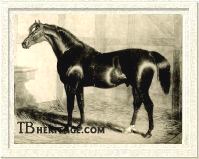
Partisan
| |
Gladiator's sire was Partisan, who was by Walton, and from Parasol, a well-bred mare and top race horse from the influential Grafton stud. Walton was a good stayer and led the sire's list in England twice. Partisan was a fast horse on the turf, and a good sire who got a leading sire son in Venison (1833), and four classic winners -- Mameluke (1824, Derby), Patron (1826, 2,000 Guineas), Cyprian (1833, Oaks) and Zeal (1818, 1,000 Guineas). In addition to Venison, who sired three classic winners, Partisan's son Glaucus (1830) sired two classic winning fillies. Another son, Godolphin (1818) also got a classic filly in Young Mouse (1826, 1,000 Guineas).
|
Gladiator's dam, the bay Pauline, was a smart filly on the turf, who ran to the age of four in top company, and, at age 3, won the Grand Duke Michael Stakes at Newmarket in 1829. Pauline was born in 1826, bred by George Payne at his Northamptonshire estate Sulby Hall, from the Selim mare Quadrille (1815), daughter of the good producing mare mare Canary Bird (1806, by Sorcerer). Quadrille was second dam, through daughter Katherine (1821, by Soothsayer) of 1,000 Guineas winner Tarantella (1830, by Tramp).
Pauline's sire, Moses (1819), was a Derby winner, in-bred four times to Herod in the fourth generation, who also won the Albany Stakes at Ascot and the Claret Stakes at Newmarket at age four. He is listed in the General Stud Book as by "Whalebone or Seymour," and therefore is listed in pedigrees as by Seymour, a Delpini son, but turf writers of the time noted that the important sire Whalebone was generally credited as his sire, and most of his siblings were by Whalebone.
George Payne had inherited £300,000 and estates in Northamptonshire, including the family home at Sulby Hall when he came of age in 1824. A gambling and racing enthusiast, he managed to lose two large fortunes, and was forced to live quietly until the 1840s, when he was left a bequest £25,000 and half the racing stable of his friend, Lord Glasgow, upon the latter's death in 1840. Payne was a well-known figure on the British turf, and a close friend of Lord Rous, Charles Greville, and other major figures in horse racing.
Pauline was sold to George Walker around the time Payne had lost so much of his inheritance through gambling that he was close to losing Sulby Hall. Walker also came into the ownership of Pauline's dam, Quadrille, at about the same time, and bred another half-dozen foals from her. In the stud Pauline produced seven foals in succession for Walker, before passing out of his hands in 1840. Gladiator, a liver chestnut colt with a "blood-like" head and "fine eyes," was her second, born in 1833.
Gladiator was sold to the trainer - jockey team, brothers John and William Scott as a yearling for £100. They, in turn, resold him for £200 to Thomas Egerton, (2nd) Earl Wilton, with a contingency of half the Derby and St. Leger winnings, should he win either, or both. Wilton was a racing enthusiast who sponsored an annual race meeting, limited to "gentlemen" riders, over his racecourse at his Heaton Park estate, near Manchester, between 1827 and 1839, which was held the week after the Doncaster St. Leger. Gladiator, described as "rather delicate, and requiring the greatest care in his training," ran at Snaresbrook, then a suburb of London, about a month before the Derby, where he strained his hock and sprang a curb. He still ran in the Derby, placing second to Bay Middleton by two lengths, and beating Venison (also by Partisan), Slane, and a field of seventeen other horses. He was favored for the St. Leger, but was too lame to run in it and was retired to stud.
Gladiator in the Stud
In England, Gladiator was only moderately successful as a sire of race horses, although he left both a daughter and a son who made great contributions in the breeding shed. He had some winners and offspring that ran in top company. His 1840 son, NAPIER, ran at Newmarket, and placed second to Cotherstone in a three-year-old stakes race there, and another son from the same crop, PRIZEFIGHTER, won the 1843 Great Yorkshire Stakes, but could not stay in the St. Leger, falling to third after leading the running. Gladiator's 1841 filly JOAN OF ARC was a good two year old who dead-heated for first in the Newmarket's Bretby Stakes with Sorrella, the latter going on to be the top three year-old filly of 1844. Other daughters included the chestnut filly HOPE (1842), who ran second in the Epsom Oaks Stakes, and his best English race filly, MISS SARAH (also 1842), who was third in the Oaks, second in the Doncaster St. Leger, and who won both the Great Yorkshire Stakes (York) and the Park Hill Stakes (Doncaster) that year.
It was a Gladiator colt of 1840, MACCABEUS, who was used by his unscrupulous owner, Goodman Levy, to run in Orlando's Derby of 1844, substituted for the three year old Running Rein. Maccabeaus (a.k.a. Running Rein in this race) won, but subsequent inquiries in the notorious court case following the protests lodged by Orlando's owner, Colonel Peel, proved "Running Rein" to be the four year old Gladiator colt. Lord George Bentinck, a member of the Jockey Club, who had declared war on the crooks and defaulters of the turf in that era, was instrumental in exposing the fraud and pursuing those involved in the deception.
|
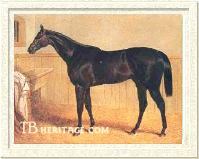
Sweetmeat
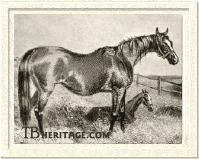
Queen Mary
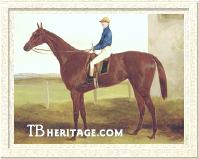
Dacia
| |
In 1842, SWEETMEAT, his best sire son, and one of his best runners in England was foaled from Lollipop by Starch or Voltaire. He won a number of races at ages two and three, his best being the Stanley Stakes at Liverpool at age 2, and the Somersetshire Stakes (Bath), the Ascot Queen's Vase, and the Doncaster Cup, in the latter beating the good race mares Alice Hawthorn and Miss Elis. In the stud he got Oaks winners Mincemeat and Mincepie, and the Derby winner Macaroni; Macaroni and another son, Parmesan , were both sires of classic winners, and a third son, Saccharometer, got Shifnal, a winner of the Grand National.
In 1843 Gladiator's most influential daughter, QUEEN MARY, was foaled from a daughter of Derby winner Plenipotentiary. She did nothing of note on the turf, but in the stud she produced, among others, Haricot, a long-running stakes winner of races such as the Lincolnshire Handicap and the Manchester Cup, and later dam of St. Leger winner Caller Ou; Bonnie Scotland, winner of the Doncaster Stakes and Liverpool St. Leger and later a leading sire in the U.S.; Derby and Oaks winner Blink Bonny, later dam of English Triple Crown winner and four-time leading sire Blair Athol; Blinkhoolie, winner of the Gimcrack Stakes, Ascot Gold Vase, and other top races; Bonnie Doon, who had two daughters sent to America to become influential broodmares there.
DACIA (1845), out of the Priam daughter Polyxena, won a handicap at Stamford for Lord Spencer, after which she was sold to Col. Jonathan Peel (brother of Prime Minister Robert Peel). For Peel she placed second to The Cur in a big field of 32 in the Cesarewitch Handicap stakes, and followed that by winning the Cambridgeshire Handicap stakes. She ran at age four, unplaced in the Chester Cup. Retired to stud, she produced two foals in England, after which she was sold to France. Through her French daughter Noelie (1859, by The Baron), she was second dam of Prix Morny winner Eole, and fourth dam of Prix du Jockey Club winner and sire Negofol. |
By 1846, Gladiator's stud fee was 25 guineas, the same fee charged for the proven race horse and sire by Partisan, Venison, and second only to the top sire of the time, Touchstone, who stood at 31 guineas. That year, the French state stud, looking to import a thoroughbred stallion to improve its racing stock, purchased Gladiator for 62,500 francs, approximately £2,000, and sent him to Haras du Pin, the principal state stud farm.
Gladiator in France
In his new home Gladiator became one of the most influential sires of the 19th century in France, and the last of the imported English stallions to have a significant influence on French breeding, the other imported sires of note from England up to that time being Royal Oak, Ion and Cadland. Up until the turn of the century, it was rare to find a top French racehorse without at least one line of Gladiator in its pedigree. One of his earliest French sons, FITZ GLADIATOR (1850) was considered the first of the "indigenous" stallions to prove himself at stud, establishing a trend in France where native stallions were supported by the breeding industry and importations of outside stallions fell dramatically. Gladiator spent ten years as a stallion in France, dying at Haras du Pin in 1857.
His principal offspring in France included:
FITZ GLADIATOR, from Zarah, was born in 1850 in M.A. Aumont's Haras de Victot. He was a fair race horse, and an influential sire in France, proving to be a sire of sires. At age three he won the Derby Continental de Gand, the Grand St. Leger de Moulins, and the Prix du Ministere at Blois; he lost to a mediocre horse, Zeste, in a race at Orleans, to whom he gave ten pounds. At age four he won a race worth 4,000 francs, and was in training for a trip cross-channel for the Goodwood Cup, when he broke down, ending his turf career. Retired to stud at Haras de Victot, he proved an enormous success at stud, and later, in 1860, was purchased by the government French state stud for 33,000 francs.
His offspring included the great race filly Gabrielle d'Estrees (1856) and Gontran (1862), both of whom won the Prix du Jockey Club; Nicolet (1864), winner of the French 1,000 Guineas; Mon Etoile (1858), a daughter of the top race filly Hervine, who was champion two-year-old filly and at age four won the Grosser Preis von Baden; Compeigne (1856), who won several races, including the Grand Saint-Leger de Moulins, and the St. Leger Continental de Bade, and went on to become the sire of Mortemer (1865), whose offspring won classics in France and the U.S., and established a highly successful line of German winners through his son, Chamant, a multiple-time leading sire in Germany. Another son of Fitz Gladiator, Vertugadin (1862), who won the Grosser Preis von Baden, got two classic winning fillies, Salterelle (1871, Prix du Jockey Club), and Mondaine (1873, French Oaks), and a son of his, Saxifrage (1877) got a number of classic winners in France, including Tenebreuse (1886, Grand Prix de Paris), and Fregate (1861, French Oaks). Fitz Gladiator also sired the 1875 Grand Steeple-Chase de Paris winner Maubourget, and several descendants of grandson Mortemer won the Maryland Hunt Cup in the U.S.
|
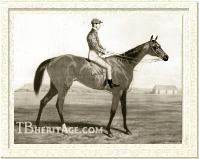
Mademoisselle de Chantilly, Prix de Diane winner
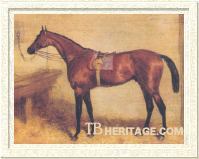
Ventre St. Gris, Prix du Jockey Club winner
| |
MADEMOISELLE DE CHANTILLY, born in 1854 from Maid of Mona, was bred and owned by Count Frederic de Lagrange. She became a top race filly who won the Prix de l'Empereur in Paris and other races at age 2, and at age 3 the French Oaks in Chantilly, then crossing the channel to win the 1858 Suburban Handicap at Epsom. In the stud she produced Promise (1869, by Monarque), second dam of the sire Acheron (1884) and of Maximum (1899), who won the Ascot Gold Cup in England.
CELEBRITY, a filly from Annetta , and HONESTY, a filly from Effie Deans, both born in 1851, were top race horses. Celebrity, owned by M.J. Reiset, ran third in the French 1,000 Guineas, and then went on to win the Prix du Jockey Club. Honesty won the French Oaks.
In that same 1851 crop of Gladiator's was COUSTRAINVILLE (from the famous English race mare Bee's Wing), who won the Grand Saint-Leger de Moulins, and placed creditably in several other races, including second the 1,000 Guineas. A Gladiator daughter SURPRISE (1857) won the French Oaks in 1860, and later produced the French classic winning filly Sornette (1867, by Light). Another 1857 filly, CAPUCINE, from Bathilde, won the Grosser Preis Von Baden at age three.
|
| Another Gladiator foal owned by Count de Lagrange was VENTRE ST. GRIS, born in 1855 from Belle de Nuit. He won the Prix du Jockey Club over a field of 24 in 1858, his first and only public outing, after which he was retired to stud. Considered "delicate," with poor legs, he was a fair sire, but amazingly, considering the assessment of his constitution, he got two winners of France's premier steeplechase, the Grand Steeple-Chase de Paris -- the mare La Veine, who won in 1870 (herself later dam of La Vigne, who won that race in 1887), and Ventriloque, who won in 1872. He also got French 1,000 Guineas winner Puebla (1863). The Epsom Oaks winner of 1897, Limasol, was by Ventre St. Gris' grandson, Poulet (1877).
|
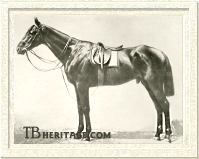
Gladiateur won the English Triple Crown and the Grand Prix de Paris
| | By far the most famous of Gladiator's grandsons, and one of the best horses ever to grace the turf in any century, was GLADIATEUR, from his daughter, Miss Gladiator, and by Monarque. Miss Gladiator won once, the Prix de l'Ecole Militarie, and injuring her leg, was retired to the breeding shed, having been purchased by the Comte de Lagrange because of her Gladiator blood. Gladiateur was her third foal, and the only one that did anything on the turf, but what he did was spectacular. He won the Grand Prix de Paris and other races in France, and England's Triple Crown races, among others, earning him the sobriquet "The Avenger of Waterloo," and everlasting recognition of his status as one of the best race horses of all time.
|
Retired to stud in France and sent to England when the Franco-Prussian war broke out, GLADIATEUR was a great disappointment as a stallion. His best son was Grandmaster, a yearling colt purchased to Australia, where he became a leading sire and exemplary broodmare sire. Through a son, Lord Gough, Gladiateur was great-grandsire of the good Irish runner and sire, Bendigo and St. Leger winner Kilwarlin, and also through Lord Gough he was grandsire of Grand National winner Eremon. A daughter was dam of Grand National Steeplechase winner Frigate and Irish Derby winner Kentish Fire.
Other daughters of Gladiator, from both England and France, of particular interest include ARELINE (1842, from a Velocipede mare), who in England produced Desdemona by Iago, third dam of Autonomy (1889, by Chester), a good race horse in Australia; BRELOQUE (1849, from Rosa Langar), third dam of the in-bred Perplexe (1872, by Vermout), sire of two top French race horses, Sycamore and Ragotsky; CONSTANCE (1848, from the race mare Lanterne), who was tail-female ancestress of classic winners in Hungary (Kordecki), Germany (Orchidee), and Argentina (Fantasia); FULVIE (1856, from Boutique), dam of Doncaster Cup winner Dutch Skater; PAPILLOTE (1856, from Agar), dam of Patricien (1864) winner of the Prix du Jockey Club; Rosati (1856, from Cingara), dam of the sire Ruy Blas (1864, by West Australian); THE BEE (1841, from Arachne, also dam of Oaks winner Industry, and second dam of Oaks winner Butterfly), who in England produced the sires Stadtholder (1855) and Yorkminster (1859); VESUVIENNE (1847, from Venus), second dam of Epsom Derby winner St. Blaise, later sent to the U.S., and tail-female ancestress of other good winners.
Gladiator sired many other good winners in France who later bred on; as noted earlier, his blood could be seen, with few exceptions, in almost every top racehorse in France in the latter half of the nineteenth century.
--Patricia Erigero
|
|
|
|

